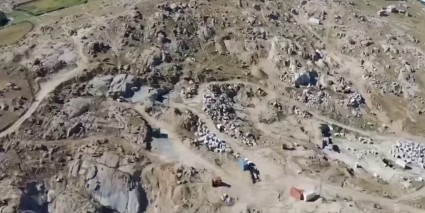The speed of recovery makes Uzbekistan the fastest growing economy in Central Asia, the European Bank for Reconstruction and Development (EBRD) says in its latest Regional Economic Prospects report, published today.
The Bank is expecting Uzbekistan’s GDP to grow by 6.8 per cent in 2021 and 6.0 per cent in 2022. Growth is supported by a remittances-led surge in private consumption along with increased investment in infrastructure, much of which has been financed through external borrowing. The forecast may be subject to further revisions because of uncertainties related to Covid-19, potential resumption of international tourism, and the geopolitical situation in Central Asia.
According to the report, services expanded by 19.5 per cent year-on-year, industrial output by 9 per cent, and agriculture by 4.2 per cent. Remittances from Russia grew by 35 per cent year-on-year in US dollar terms in the first eight months of 2021. Credit growth accelerated to 22 per cent in June 2021 in real terms compared to 12 per cent a year ago, reflecting stronger economic activity. Despite expansionary measures, inflation eased from 11.1 per cent year-on-year in December 2020 to 10.8 per cent year-on-year in October 2021.
Overall, the EBRD raised its forecast for all its regions for 2021 to 5.5 per cent. While this represents an upward revision of 1.3 percentage points over its June forecast following a strong performance in the first half of the year, the Bank warns of serious threats ahead.
High commodity and energy prices, tight labour markets, supply chain disruption and currency depreciations in some EBRD economies have begun to push up inflation even before the latest spike in Covid-19 infection cases. On average, inflation in the EBRD regions exceeded its end of 2019 levels by 3 percentage points in September 2021. In response, a number of central banks in the EBRD regions have raised policy interest rates.
In some EBRD economies tight labour markets added to inflationary pressures with a strong rebound in vacancies in lower-medium skilled occupations. In other economies, considerable slack in labour markets remains. Unemployment increased by 1.4 percentage points on average between February and August 2020, while labour force participation fell by half a percentage point on average.
EBRD Chief Economist Beata Javorcik said: “This is a bittersweet recovery. The first half of 2021 brought a robust rebound. But we are now seeing growing cause for concern. While high commodity prices benefit exporters, they weigh heavily on the trade balances of importers. The supply of affordable energy as we enter the winter period is becoming a serious worry, especially since governments’ headroom is limited.”
Following large stimulus packages in response to the Covid-19 crisis, public debt in the EBRD regions has increased by an average of 13 percentage points of GDP since the end of 2019. While borrowing costs remain below their pre-crisis levels in most economies, they have risen sharply in some countries.
The recovery gathered pace in the EBRD regions in the first half of 2021 when output grew by 6.4 per cent year-on-year. Mobility recovered earlier than in other parts of the world, while industrial production and retail sales rebounded. Exports of goods and services increased despite temporary supply chain disruptions. Remittances also grew in the second quarter of 2021, in some cases surpassing 2019 levels. Tourist arrivals exceeded expectations, but remained significantly below their 2019 levels in most EBRD economies.
In 2022, as economies recover, growth is expected to moderate to 3.8 per cent in the EBRD regions. This is 0.1 percentage point lower than expected in June 2021. However, forecasts are subject to high uncertainty, reflecting risks associated with the future path of Covid-19, possible worsening of external conditions and weaker growth in trading partners.
More widespread inflationary concerns may bring forward policy tightening in advanced economies, making debt burdens more expensive to service, the report warns. Travel restrictions and lingering fears of contagion continue to weigh on the outlook for the tourism sector. While bankruptcies have so far remained contained, further vulnerabilities may surface once policy support is reduced.
Output in central Europe and the Baltic states is expected to increase by 5.2 per cent in 2021 and 4.7 per cent in 2022, reflecting better-than-expected results in the first half of 2021, although supply chain disruptions weighed on growth in some economies.
In the south-eastern European Union GDP is expected to grow by 6.7 per cent in 2021 and 4.3 per cent in 2022. These figures reflect a significant upward revision to growth in Greece, although tourist arrivals remain below their 2019 levels.
Output in the Western Balkans is expected to grow by 6.4 per cent in 2021 and 4 per cent in 2022. The region saw significant upward revisions, reflecting better-than-expected performance in the first half of the year, including in the tourism sector, as well as strong export demand from the EU market.
Output in Russia is expected to grow by 4.3 per cent in 2021 and 3 per cent in 2022, boosted by public spending programmes facilitated by higher commodity revenues.
In eastern Europe and the Caucasus output is expected to grow by 3.6 per cent in 2021 and 2.9 per cent in 2022, reflecting strong results in the first half of the year, although there are signs of momentum slowing in the third quarter.
Turkey’s economy is expected to grow by 9 per cent in 2021 and 3.5 per cent in 2022, supported by a post-lockdown rebound in domestic demand and strong exports benefiting from currency depreciation. Risks to macroeconomic stability have, however, increased.
Output in the southern and eastern Mediterranean is expected to grow by 4.2 per cent in 2021 and 4.4 per cent in 2022, reflecting strong pick-up in economic activity in Egypt in particular in the second quarter of 2021.












